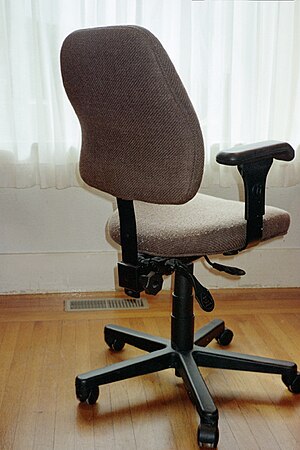Office chair
This article has multiple issues. Please help improve it or discuss these issues on the talk page. (Learn how and when to remove these template messages)
|

An office chair, or desk chair, is a type of chair that is designed for use at a desk in an office. It is usually a swivel chair, with a set of wheels for mobility and adjustable height. Office chairs were developed around the mid-19th century as more workers spent their shifts sitting at a desk, leading to the adoption of several features not found on other chairs.
History
One of the earliest known innovators to have created the modern office chair was naturalist Charles Darwin, who put wheels on the chair in his study so he could get to his specimens more quickly.[1]
With the advent of rail transport in the mid-19th century, businesses began to expand beyond the traditional model of a family business with little emphasis on administration. Additional administrative staff was required to keep up with orders, bookkeeping, and correspondence as businesses expanded their service areas. While office work was expanding, an awareness of office environments, technology, and equipment became part of the cultural focus on increasing productivity. This awareness gave rise to chairs designed specifically for these new administrative employees: office chairs. This caught the attention of Otto von Bismarck, who is credited with popularizing the office chair by distributing them throughout parliament during his time in office. American inventor Thomas E. Warren (b. 1808), designed the Centripetal Spring Armchair in 1849 which was produced by the American Chair Company in Troy, New York. It was first presented at the 1851 Great Exhibition in London.[2]
The office chair was strategically designed to increase the productivity of clerical employees by making it possible for them to remain sitting at their desks for long periods of time. A swiveling chair with casters allowed employees to remain sitting and yet reach a number of locations within their work area, eliminating the time and energy expended in standing. The wooden saddle seat was designed to fit and support the body of a sitting employee, and the slatted back and armrests provided additional support to increase the employee’s comfort. Like modern chairs, many of these models were somewhat adjustable to provide the maximum comfort and thus the maximum working time.
Ergonomics
In the 1970s, ergonomics became an important design consideration. Today, office chairs often have adjustable seats, armrests, backs, back supports, and heights to prevent repetitive stress injury and back pain associated with sitting for long periods. Ergonomic chairs fit an individual's needs and provide support where the individual needs it.
Standard for design and testing
- EN 1335
- EN 1728
- ANSI/BIFMA X 5.1
- DIN EN 1335
- DIN 4551
Criticism
People who sit at their jobs have increased blood pressure and blood sugar,[3] purely from the act of sitting. In addition to burning chemical energy themselves through oxidative phosphorylation, human muscles also produce a variety of substances involved in metabolizing fat and cholesterol. However, neither of these occur when the muscle is not in use, and very little muscle mass is actively used in most desk tasks. To compensate for the lack of movement while sitting at the office for long periods, it has been suggested that full-time seated workers would need to walk an extra 19 km per day.

See also
References
- ^ Gregory Katz. "On Darwin's 200th, a theory still in controversy" East Valley Tribune February 8, 2009 [dead link]
- ^ A History of American Manufactures from 1608 to 1860, Exhibiting at the London World's Fair, Volume 2; By James Leander Bishop, Edwin Troxell Freedley, Edward Young; retrieved Google Books, June, 2012.
- ^ http://opinionator.blogs.nytimes.com/2010/02/23/stand-up-while-you-read-this/?hp
